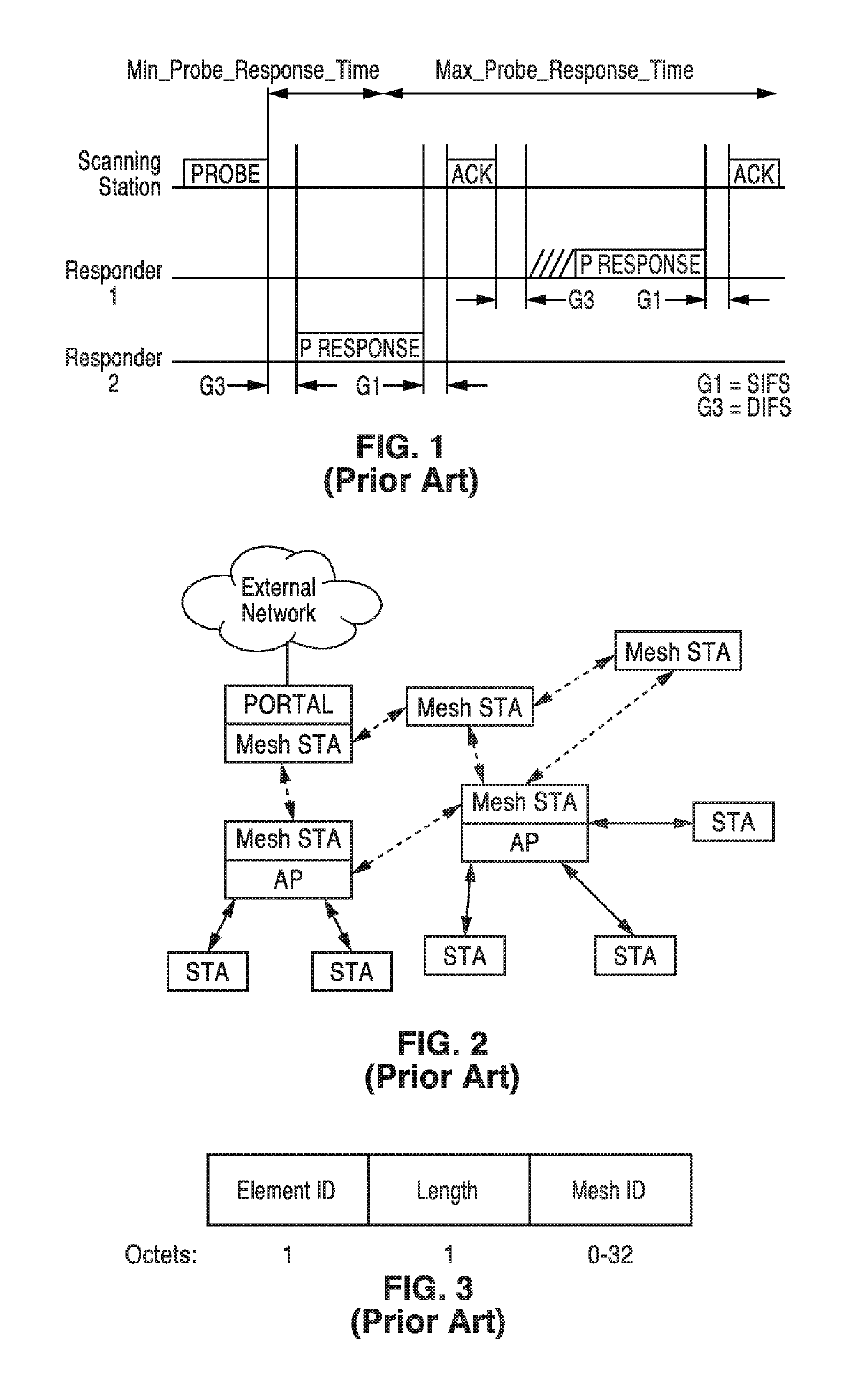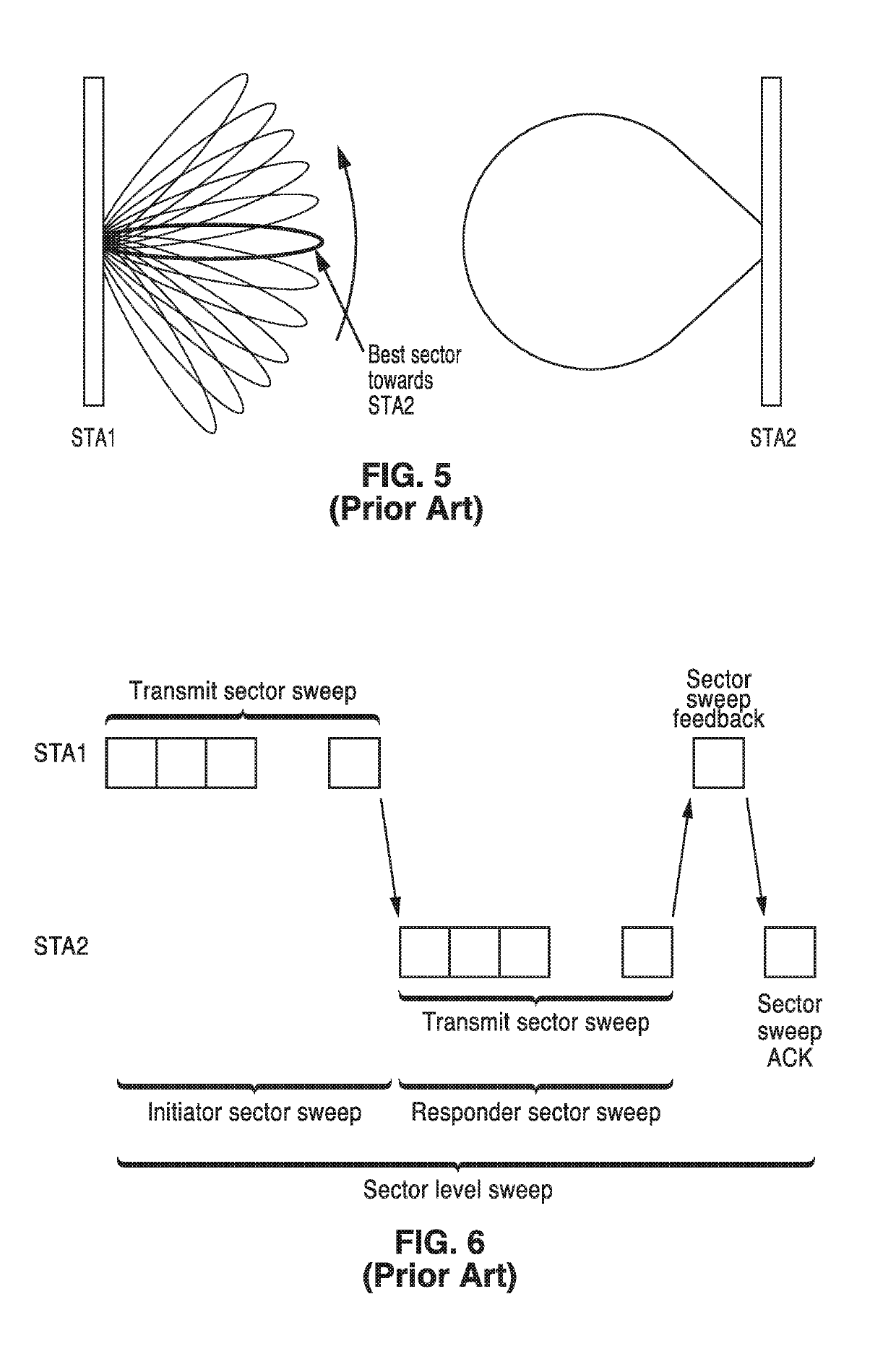Beaconing in small wavelength wireless networks
a wireless network and small wavelength technology, applied in the field of directional wireless communications, can solve the problems of high data demand, high loss of free-space paths, high penetration, etc., and achieve the effect of improving the mechanism of beaconing
- Summary
- Abstract
- Description
- Claims
- Application Information
AI Technical Summary
Benefits of technology
Problems solved by technology
Method used
Image
Examples
embodiment 150
[0158]FIG. 17 illustrates an embodiment 150 of a node 152 transmitting in directions 154a through 154n, during sweeping 156 of a mesh network discovery frame in a quasi-Omni directional transmission.
[0159]4.4. Efficient BF Training through Peer and Discovery Beacons
[0160]4.4.1. Peer Beacon Updates
[0161]In directional communications, e.g. 60 GHz WLAN, beacon transmissions may be utilized in at least one embodiment of the present disclosure as part of the BF training required to establish robust communications between peers. The discovery beacons described herein can initiate the BF training, such as for example using SLS phase.
[0162]A mesh node records the best sector information from the BF training that happens during and shortly after transmitting the discovery beacons. For peer beacons, the mesh node transmits beacons only in sectors corresponding to best sectors towards peer mesh nodes.
[0163]FIG. 18A and FIG. 18B illustrate an example embodiment of providing additional robustnes...
embodiment 230
[0166]FIG. 20 illustrates an embodiment 230 of training database creation and updates. After a few beacon intervals (BIs), the BF training may need to be updated. The discovery beacons provide either the refresh cycle of the BF training or a BF training with a new peer node.
[0167]The process commences 232 with discovery beacons being received 234 from STA n, followed by retrieval 236 of an entry of STA n in a record of best sectors from record of best sectors 238. A check 240 is made to determine if STA n has an entry in the record of best sectors. If there is no such entry, then an entry is made 242 into the record of best sectors 238. Otherwise, if there is an existing entry, then the existing and current data are compared 244 and BF training information is updated 246 for STA n prior to the processing ending 248.
[0168]4.5. Steady State BM Handling Protocol
[0169]4.5.1. Master Beacon Switching
[0170]The network in steady state moves (rotates) the beacon masters among the network nod...
embodiment 910
[0257]In FIG. 37 embodiment 910, a number of network entities are depicted as new node 912 seeking to join the network, neighbor 1 node 914, neighbor 2 node 916, neighbor 3 node 918, beacon master 920, central entity 922 and mesh node 924. Beacon master 920 sends 926 discovery beacons in all directions, 928, 930 and 932, with these beacons reaching the new node in this case. The new node 912 responds with beacon response 934 to the beacon master 920 which announces 936 the new node to the central entity 922. The central entity then announces 938 the beacon master schedule to all nodes 940, 942, 944, 946, 948, except the new node 912. When helpful, the neighbor that discovered the new node sends the new node a frame to tell that node about the new schedule and some information that aids beamforming with other neighbor. Neighbor 3 node 918 generates 950 discovery beacons in all directions 952, 954, 956. New node 912 responds with a beacon response 958 to neighbor 3 node 918. Neighbor ...
PUM
 Login to View More
Login to View More Abstract
Description
Claims
Application Information
 Login to View More
Login to View More - R&D
- Intellectual Property
- Life Sciences
- Materials
- Tech Scout
- Unparalleled Data Quality
- Higher Quality Content
- 60% Fewer Hallucinations
Browse by: Latest US Patents, China's latest patents, Technical Efficacy Thesaurus, Application Domain, Technology Topic, Popular Technical Reports.
© 2025 PatSnap. All rights reserved.Legal|Privacy policy|Modern Slavery Act Transparency Statement|Sitemap|About US| Contact US: help@patsnap.com



